CHAPTER X
PALAEOLITHIC ASSEMBLAGES FROM THE DOUARA CAVE SITE
Takeru AKAZAWA
Department of Anthropology and Prehistory, The University Museum, The University of Tokyo
| ( 2 / 7 ) |
|
|
Typological Indices:
|
Bordes and Bourgon (1951) further established four "typological groups", reflecting specific tool classes within the standard Middle Palaeolithic type list (Bordes, 1961). The relative quantity of each group is calculated as a percentage of the total of tools classifiable into the 63 standard types.
- Typological Groups:
- I = Levallois Type Tools (Bordes' standard type list 1 through 4),
- II = Mousterian Type Tools (types 5 through 29),
- III = Upper Palaeolithic Type Tools (types 30 through 37),
- IV = Denticulate Tools (type 43).
For the assemblages from Layers A and B, the Sonneville-Bordes and Perrot' (1954-1956) and Sonneville-Bordes' (1960) schemes had to be introduced in order to clarify rela tionships between tool types and their blank forms: that is to say, tools made on different blanks-flakes, blades or bladelets-are categorized into the same tool group.
The description moves from the lower to the upper layers.
2) Description of Flint Artifacts by Layer
LAYERS I THROUGH F
Flint artifacts from these layers were scarce. The relative quantities of artifacts in each layer are shown in Table X-1. Each layer yielded at least one specimen classifiable as a tool, with most of the remaining pieces consisting of waste flakes or debris.

Layer I (6 pieces)
Flint artifacts were obtained only from Units 7-7 and 7-10 of Trench B in Layer I. A total of six pieces were found. These consist of four specimens classifiable as tools, one frag ment of a piece with a faceted striking platform and one piece of debris.
The four tools are divided into the following four types: a dark brown, flint Levallois flake with a faceted striking platform and no retouch (Fig. X-3, No. 1); a light brown, flint Levallois blade with a truncated, faceted butt (Fig. X-3, No. 4); a single convex type side scraper (Fig. X-3, No. 2), and an extensively retouched core rejuvenation flake (Fig. X-3, No. 3). The scraping edge of the side-scraper is formed by scaled retouch along the proximal edge of a Levallois blade with a faceted butt. The extensive retouch on the core rejuvenation flake is from secondary use. The striking platform was removed leaving a more or less concave truncation. This flake is of the type thought to be produced from the Levallois flake type core such as was found in Layer E of this site (Fig. X-5, No, 1), or the Jefr Ajla type Levallois core such as found in Layer C of this site (Fig. X-27, No. 6).
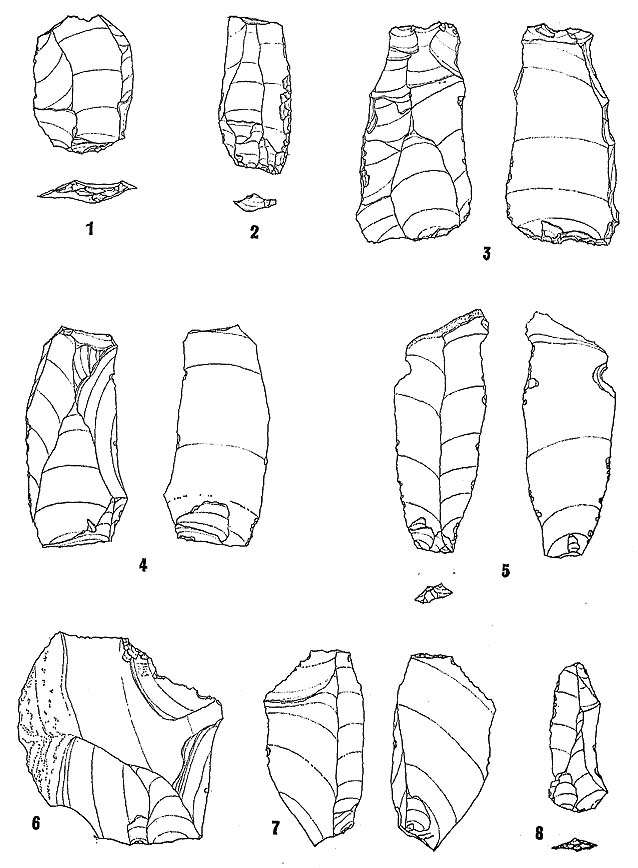 Figure X-3. Flint implements from the Douara Cave. Layers F through I. (Scale 2/3). 1. D71016-1074* Levallois flake, typical (Layer I) 2. D71016-1075 Side-scraper, single convex type, on a Levallois blade (broken tip) (Layer I) 3. D71016-1073 Core rejuvenation flake, with truncated faceted butts at both ends (Layer I) 4. D70715-1076 Levallois blade, with a truncated faceted butt (Layer I) 5. D70714-1072 Notched piece, on a non-Levallois blade (Layer H) 6. D70714-1144 Non-Levallois flake, slightly retouched (Layer F) 7. D71017-1069 Truncated piece, on a non-Levallois flake (Layer G) 8. D71406-1068 Levallois blade (Layer F) * No. D71016-1074 means D-7-10-16-1074. D is the first letter of Douara, The first and second numerals coincide with the number of unit producing the specimen and the third numeral shows the number of a cloth-bag in the unit. The last numeral is the serial number of the specimen in the site. |
 Figure X-5. Flint implements from the Douara Cave. Layer E, Levalloiso-Mousterian. (Scale 2/3).
|
 Figure X-27, Flint implements from the Douara Cave.
|
Layer H (4 pieces)
Four flint artifacts were found in Layer H, three pieces in Unit 7-7 and one in Unit 6-13. These pieces consist of two tools and two unclassified broken pieces. One tool is a notched piece on a non-Levallois blade with a faceted butt, and has extensive edge-retouch from secon dary use along its entire margin (Fig. X-3, No. 5). The other tool is on a non-Levallois flake with a smooth butt, and has signs of secondary use along its distal end. The two broken pieces have faceted striking platforms. All four flints are brown in color.
Layer G (3 pieces)
Three flint artifacts were collected from Layer G. One shows some secondary modification, but the other two are waste flakes. These flints are brown or bluish gray. The piece clas sifiable as a tool is made on a non-Levallois flake with a smooth butt and a straight truncation at its distal end (Fig. X-3, No. 7). It has some edge-retouch from secondary use along its left margin.
Layer F (4 pieces)
Four flint artifacts were obtained from Layer F in Unit 7-14 of Trench B. These pieces consist of two tools and two unclassified, broken pieces. One tool is a Levallois blade with a faceted butt and has some signs of secondary use along its edges (Fig. X-3, No. 8). The other tool is a utilized non-Levallois flake, partially retouched along its distal end (Fig. X-3, No. 6).
LAYER E: MIDDLE PALAEOLITHIC
The flint artifacts from Layer E were obtained from one unit in Trench A, 12 units in Trench B and all the units in Trench C (Table X-60). The following description of these flint remains is based on 318 pieces, consisting of 204 flakes, blades and points, one core tool, 23 cores and 90 waste flakes and other debris (Table X-2). The flint artifacts in this layer are usually patinated dark brown, bluish or blackish gray.

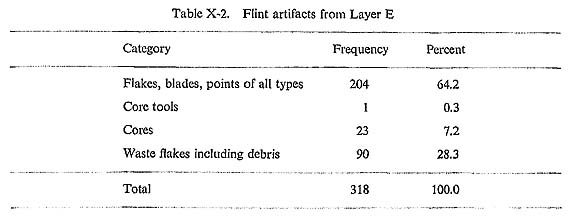
TECHNOLOGICAL DESCRIPTION
Blanks
The technological categories of the tool blanks in this layer are Levallois type, 145 blanks, non-Levallois types, 33 blanks, and one core tool (Table X-3).
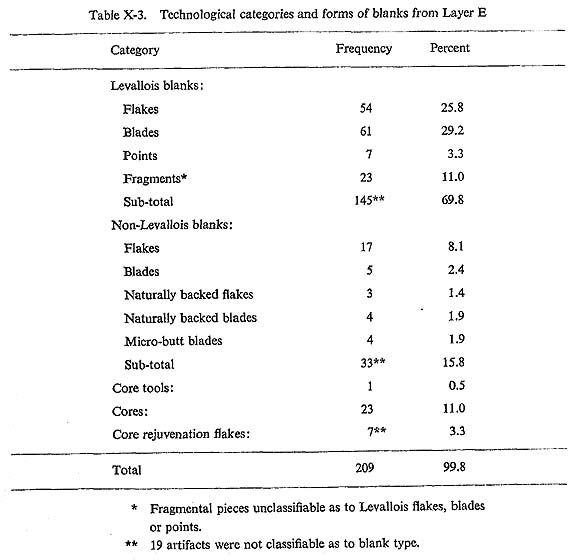
The most striking feature of the lithic assemblage from this layer is the dominant role played by the Levallois technique in the production of tool blanks. This is clearly seen in the extremely high Levallois Index (IL), 77.7.
The Faceting Index (IF) is also high at 74.8 or in the strict sense, 63.3. On the other hand, the relative quantity of blades (elongated flakes whose length is greater than twice their width) is only moderately high. The Blade Index (ILam) is 47.7. This value reflects a strong tendency seen in this layer for the production of elongated blanks. Table X-4 shows the technological indices for the assemblage from Layer E.

In contrast to the extremely high value for the Levallois technique used in the production of tool blanks, the proportion of non-Levallois blanks upon which tools are made is, as a matter of course, extremely low. These non-Levallois blanks consist of flakes and blades, naturally backed flakes and blades, and micro-butt blades (Table X-5). The majority are non-Levallois flakes and blades. The quantity of naturally backed flakes and blades is less in com-parision with those of the succeeding Layers D and C (Fig. X-11, Nos. 9-11). The micro-butt blades have extremely tiny and smooth butts, which are in striking contrast to the butt forms on the other blanks. This form suggests that a lithic technique markedly different from the Levallois technique was employed for the production of these blanks (Fig. X-11, No. 1).

 Figure X-11. Flint implements from the Douara Cave. Layer E, Levalloiso-Mousterian. (Scale 2/3).
|
The frequency distribution of the lengths of the unbroken flake blanks is given in Table X-6. The mean length of the blanks in this layer shows the highest value among the assem blages from Layers C, D and E. This means that the blank sizes become shorter from the lower to the upper assemblage.
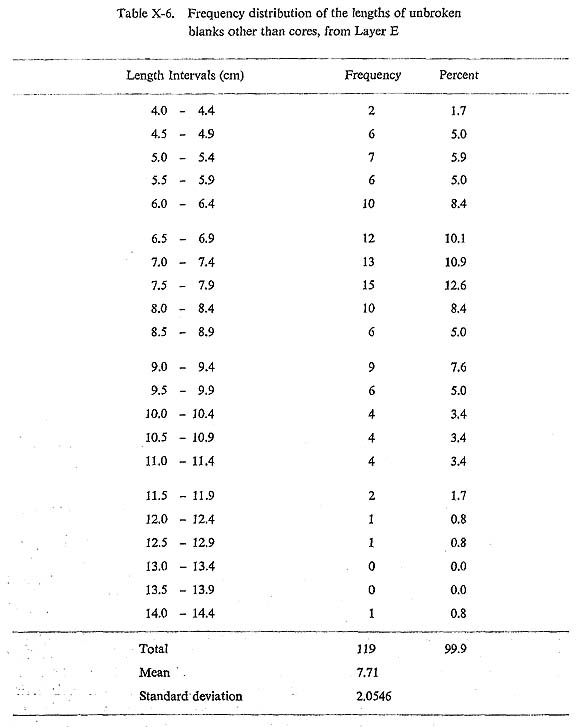
Cores
The 23 cores from this layer fall into five categories (Table X-7). The majority of these cores belong to Levallois category (10).
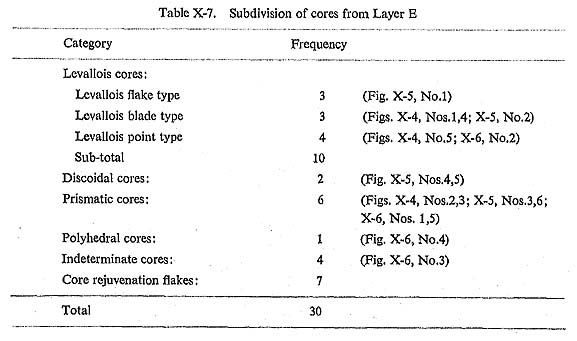
The Levallois cores fall into three forms following from the type of blank intended. The Levallois flake cores (3) are generally characterized by having cortex on their reverse surfaces and faceted striking platforms. They are roughly rectangular to oval in outline, with uni directional or bi-directional (from opposing directions) scars on their flaking surfaces (Fig. X-5, No. 1). The Levallois blade cores (3) are generally rectangular in outline with uni-direc tional or bi-directional (from opposing directions) parallel flaking on their flaking surfaces (Figs. X-4, Nos. 1, 4; X-5, No. 2). They are generally characterized by having cortex on their reverse surfaces. In cross-section they are generally trapezoidal. The Levallois point cores (4) are roughly triangular in outline with generally uni-directional flaking scars on their flaking surfaces (Figs. X-4, No. 5; X-6, No, 2). The Levallois cores are somewhat variable in form, but they share several characteristic features: all of the cores have more or less centripetal flaking scars around the perimeter of their upper and reverse surfaces but have cortex on most of the reverse surface (opposed to the main flaking surfaces). The striking platforms are generally prepared by intensive secondary faceting.
 Figure X-4. Flint implements from the Douara Cave. Layer E, Levalloiso-Mousterian. (Scale 2/3).
|
 Figure X-6. Flint implements from the Douara Cave. Layer E, Levalloiso-Mousterian. (Scale 2/3).
|
The second most common type of core is the prismatic core (6). These are less variable than the Levallois cores. They are characterized by a generally prismatic form, cortex on their reverse surface, a dome-shaped or trapezoidal cross-section, a series of parallel, uni-directional flaking scars showing a number of removals from a single-plane striking platform, and a flaking surface that extends around the piece rather than being a single flat surface as on the Levallois cores (Figs. X-4, Nos. 2, 3; X-5, Nos. 3, 6; X-6, Nos. 1, 5). It is possible that some of the flakes and blades that have been classified typologically as Levallois pieces, were removed from these prismatic cores.
Besides the Levallois and prismatic cores, indeterminate (4), discoidal (2) and polyhedral (1) type cores were collected from Layer E. The discoidal cores are either flat-shaped or tortoise shaped in profile, and round in outline. A number of flakes are removed from around the perimeter on the main flaking surface of the core rather than uni- or bi-directionally from one or both ends, as in the case of Levallois or prismatic cores (Fig. X-5, Nos. 4, 5). The polyhedral core is characterized by a trigonal pyramidal shape, produced by the over-all preparation of the core. A number of flakes are removed from around the core surfaces from a number of faceted striking platforms (Fig. X-6, No. 4).
The indeterminate cores consist of fragments (broken pieces) of the preceding type cores and raw flint materials with few flaking scars (Fig. X-6, No. 3).
It is possible that core size corresponds to blank size. To examine this we compared core lengths by measuring the maximum length of the primary flaking surface along the long axis of the major flaking scars or, in the case of discoidal or polyhedral cores, the length of the largest flaking scar. Table X-8 gives the mean length of each core type and blank type from Layer E.
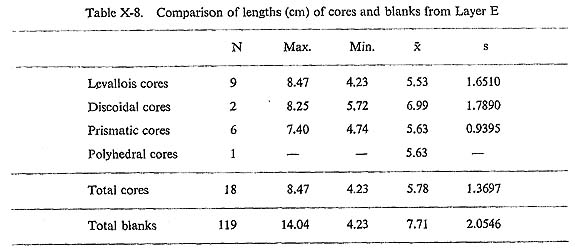
Also in this layer we found a number of core rejuvenation flakes (Table X-7). Some of these were secondarily retouched and served as blanks for tools such as a graver.
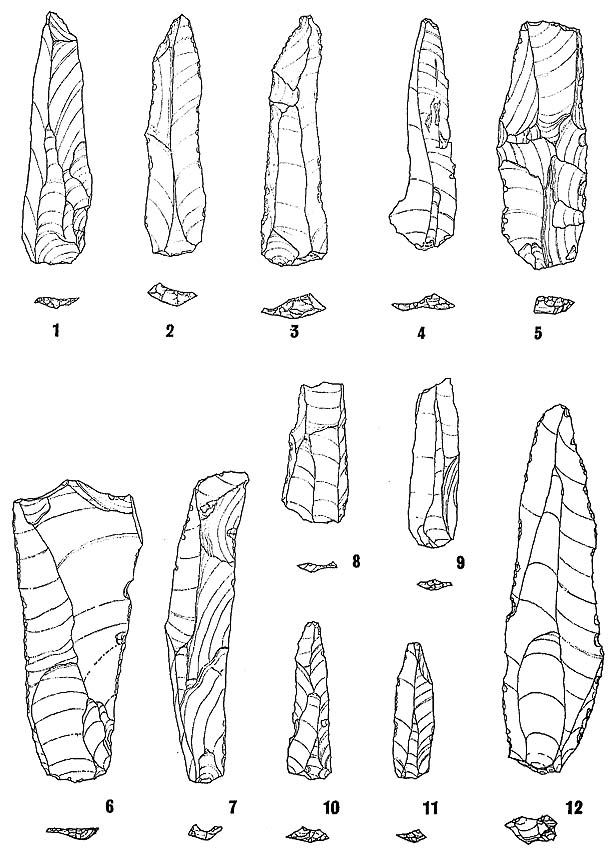 Figure X-8. Flint implements from the Douara Cave. Layer E, Levalloiso-Mousterian. (Scale 2/3).
|
TYPOLOGICAL DESCRIPTION
Of the 318 flint artifacts from Layer E, 159 are classifiable as tools. The great majority of these are Levallois type tools, and the remainder are Mousterian, Upper Palaeolithic and miscellaneous (including denticulates) type tools. Table X-9 gives the typological groups and their indices obtained from the total classifiable specimens.
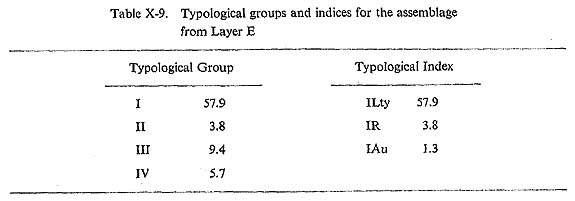
Levallois Type Tools (92 pieces)
Bordes defines the Levallois tool category (Bordes' standard type list 1 through 4) as including those flakes that were intentionally shaped on the core before removal but which are without significant secondary retouch along the margins (Bordes, 1961 :18).
Bordes subdivides the Levallois tools into the three categories, flakes, points and retou- ched points, but Schroeder (1969 :107) extended slightly Bordes' categorization by further subdividing the Levallois flakes into flakes and blades, in order to segregate pieces whose length is greater than twice their width. He also subdivided the Levallois points into regular and elongated, the latter being points whose length, like that of Levallois blades, is twice their width.
The majority of flint implements from this layer are Levallois type, which is expressed by the Index of Levallois Type (ILty), 57.9, and most of these are flakes (to include blades). The Levallois points are few and are of both the regular and elongated types.
Interestingly, over 50 percent of the Levallois flakes and points are elongated (their lengthsare greater than twice their widths) (Table X-10). This suggests a tendency toward the production of elongated blanks which contrasts with succeeding layers.

Table X-11 gives the length-width ratios only for unbroken Levallois type tools from this layer.
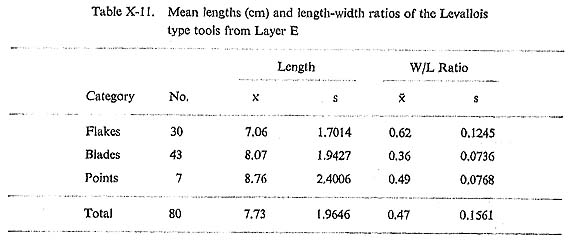
Table X-12 gives a breakdown of the Levallois tools on the basis of the manner of plat form preparation which they exhibit. The majority of the Levallois tools have the faceted striking platform. However, the Levallois tools with the smooth butt have a moderately high fre quency. It is probable that they are produced from some of the prismatic type cores with no elaborate platform preparation (Fig. X-6, Nos. 1, 5).
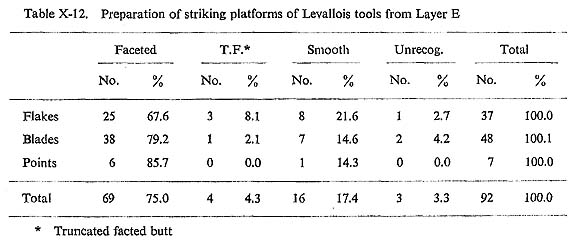
Mousterian Type Tools
The Mousterian category includes only various side-scrapers, and its index at 3.8 is extremely low.
Side-scrapers (6 pieces)
Side-scrapers are not common in the assemblage from this layer (Table X-65), as is ex pressed by the Index of Side-scrapers (IR), 3.8. The subdivision of the side-scrapers according to Bordes' typological categorizations is given in Table X-13.
   |
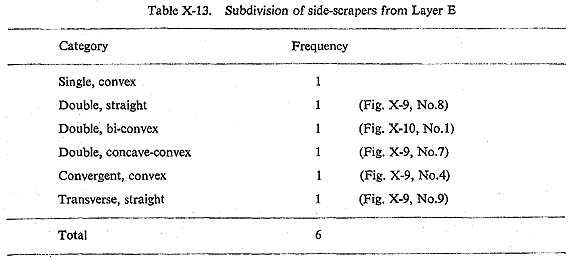
The blanks on which these side-scrapers are made are both Levallois (Figs. X-9, No. 7; X-10, No. 1) and non-Levallois (Fig. X-9, No. 4). There are two categories of retouch used to shape the scraping edges: flat, scaled retouch (Figs. X-9, Nos. 8, 9; X-10, No. 1), and fine, semi-abrupt retouch, best observed under a lens (Fig. X-9, Nos. 4, 7). The last type of retouch strongly resembles the retouch on the lateral edges of Mousterian raclettes, but it is not soabrupt and is combined, in every case, with roughly flat, scaled retouch.
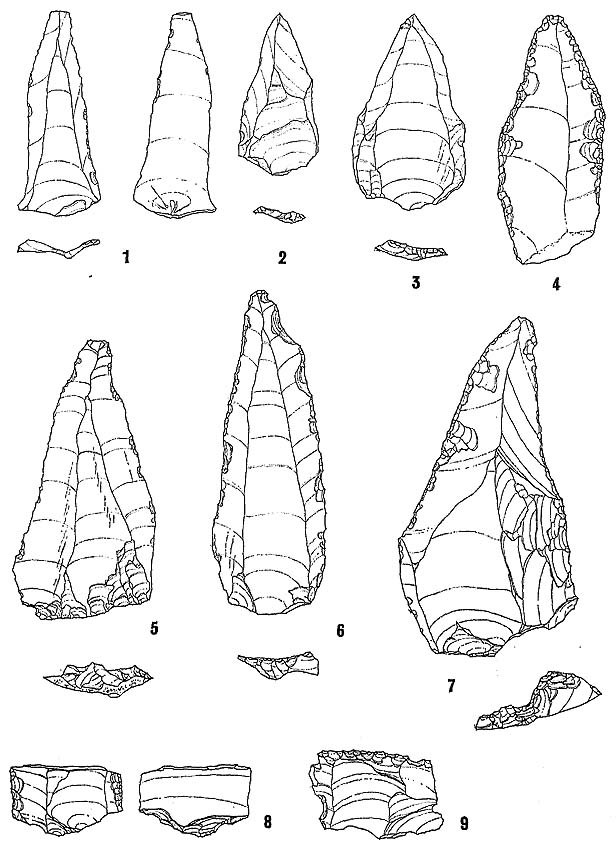 Figure X-9. Flint implements from the Douara Cave. Layer E, Levalloiso-Mousterian. (Scale 2/3).
|
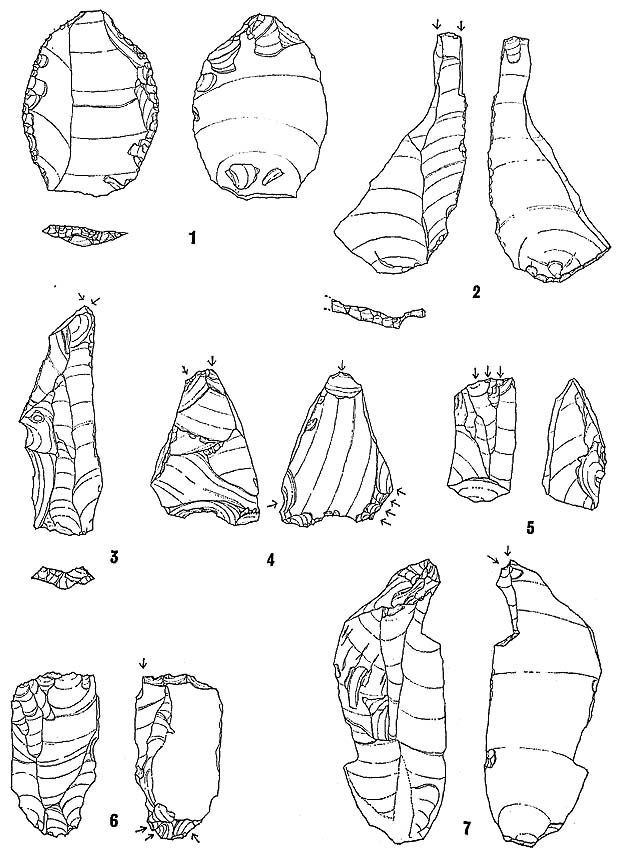 Figure X-10. Flint implements from the Douara Cave. Layer E, Levalloiso-Mousterian. (Scale 2/3).
|
Upper Palaeolithic Type Tools
Upper Palaeolithic type tools in Layer E are few and have an index value of 9.4 (III). These tools consist of gravers, perforators and backed knives.
Gravers (11 pieces)
Among the Upper Palaeolithic type tools from this layer the gravers are the most abun dant. These gravers are classified according to Bordes' typology as subdivided by Sonneville-Bordes and Perrot (1954-1956) (Table X-14).
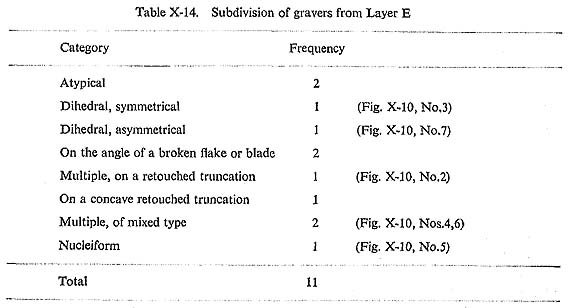
Two of these eleven pieces are atypical because, even though they possess graver facets, there is no clear indication of the chisel-like working edge seen on a typical graver facet. The working edges of two gravers are formed by the intersection of a graver facet with one or another type of truncated edge (Fig. X-10, No. 2). Two other gravers have working edges for med by the intersection of a graver facet with the snapped edge of a broken flake or blade. Two pieces are classed as multiple gravers of mixed type: one piece has an angle facet inter secting with a straight truncation at one end and three transversal, flat-faced spall scars on the ventral surface at the other end (Fig. X-10, No. 6); and another piece is a broken flake or blade of roughly triangular outline, having several graver facets formed on three corners of the piece (Fig. X-10, No. 4). Two pieces are gravers with two spalls meeting at the distal end of the blank (Fig. X-10, Nos. 3, 7), and one piece is a nucleiform graver with a number of ad jacent spalls removed forming a chisel-like edge at the end of a broken, prismatic type core (Fig. X-10, No. 5).
Perforators (2 pieces)
Both perforators occur at the distal ends of Levallois blanks and are classified as atypical, because the tips of the perforators are not prominent and were formed by alternating retouch slightly modifying the pointed ends of the blanks (Fig. X-7, No. 5).
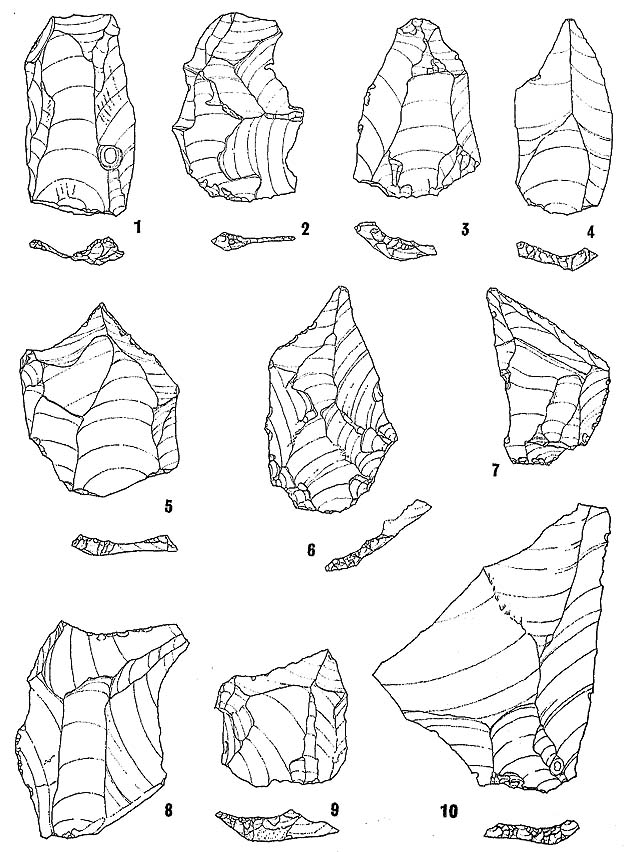 Figure X-7. Flint implements from the Douara Cave. Layer E, Levalloiso-Mousterian. (Scale 2/3).
|
Backed Knives (2 pieces)
The remaining Upper Palaeolithic type tools are backed knives. Both specimens of this type are atypical and exhibit abrupt blunting retouch only along the distal or proximal part of one margin of the flake. One is made on a Levallois blade with a truncated faceted butt (Fig. X-11, No. 12), and the other is on a non-Levallois flake with a faceted butt.
Miscellaneous Tool Categories
Naturally Backed Knives (7 pieces)
This tool type is characterized by the presence of a naturally blunted edge, usually cortex, which extends along one margin of a flake or blade (Fig. X-11, Nos. 9-11). The straight or concave opposite margin has a naturally sharp cutting edge, usually edge-retouched from secondary use. Most of the pieces give the impression of having been intentionally prepared while still on the core-they retain several flaking scars on the dorsal surface. However, it is possible that some are waste flakes produced originally in the preparation of the perimeter of a Levallois core but used secondarily as tools. Three of these knives are on flakes and four are on blades.
Truncated Pieces (5 pieces)
These pieces are characterized by the presence of abrupt and regular retouch along varying portions of their edges. Two pieces are straightly truncated perpendicularly to the long axis of the flake (Fig. X-11, No. 6). One piece is truncated obliquely to the axis of the flake, and another piece is slightly concave (Fig. X-11, No. 2). The remaining piece has an obliquely convex truncation at the base of a flake blank (Fig. X-11, No. 5). The retouch along the edges of these flakes is usually semi-abrupt and not so typical, and, accordingly, the truncations differ somewhat from those of typical truncated pieces.
Notched Pieces (14 pieces)
Notched pieces are the most abundant type in the miscellaneous tool category. These pieces are a series of flakes or blades into which are retouched usually single notches on one margin. The retouch forming the notch is from either the ventral surface (Fig. X-11, Nos. 4, 7) or the dorsal surface (Fig. X-11, No. 8). It is difficult to separate naturally notched pieces from artificially notched ones. Natural crushing of the edges of a piece of flint is usually abrupt, irregular and generally intermittent on both faces of the flake. Therefore, only pieces which have been elaborately and clearly retouched by man, have been counted here as notched pieces.
Denticulate Pieces (9 pieces)
Included in this category are pieces which morphologically resemble notched pieces but whose edges exhibit a contiguous series of notches or indentations formed by adjacent retouch flake scars (Fig. X-12, Nos. 2, 4, 5). The extensiveness and the portions of the working edges varies. Most pieces have denticulations along one or both edges and on either the ventral or dorsal surfaces. One striking example has a working edge with a contiguous series of retouch notches on both faces along one edge (Fig. X-12, No. 5). Five pieces are on Levallois blanks and four are on non-Levallois flakes.
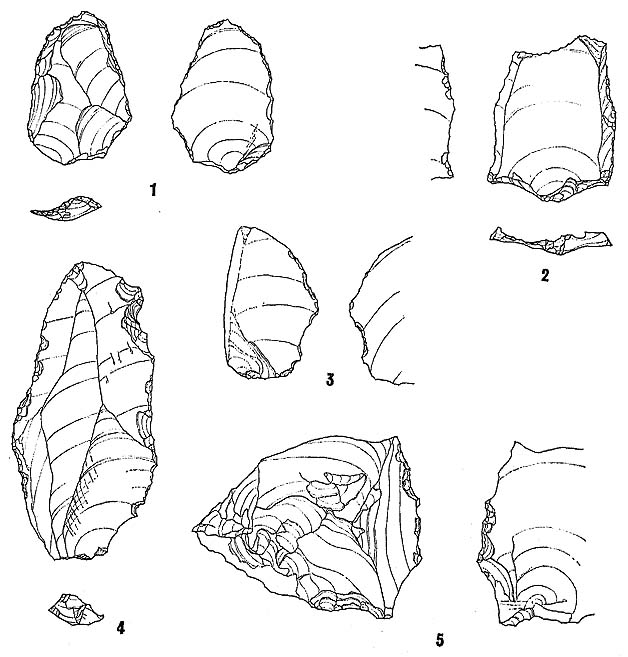 Figure X-12. Flint implements from the Douara Cave. Layer E, Levalloiso-Mousterian. (Scale 2/3).
|
Becs Burinantes Alternes (3 pieces)
This tool category has been defined by Bordes (1961 : 37) as having a projection ridge formed by the intersection of two retouched notches, one on the dorsal surface and the other on the ventral surface. All three examples from Layer E have projections created by the inter section of two shallow retouch notches (Fig. X-12, Nos. 1, 3). Two of the pieces are made on Levallois flakes, and the other is on a naturally backed flake.
Piece with Retouch on the Ventral Surface (1 piece)
This piece is retouched partially along both edges on the ventral surface of a non-Levallois flake.
Notches on the End of a Flake (2 pieces)
The notches are formed by fine, more or less semi-abrupt, regular retouch at the distal end of a flake, indicating that they were intentionally formed. One piece is on a Levallois flake (Fig. X-11, No. 3) and the other is on a non-Levallois blade with a micro-butt (Fig. X-11, No. 1).
Miscellaneous Pieces (5 pieces)
Included in this category are all miscellaneously retouched pieces, all of which are frag mental and cannot be placed in one of the other tool types. Three pieces are on Levallois flakes or blades and two are on non-Levallois flakes.





